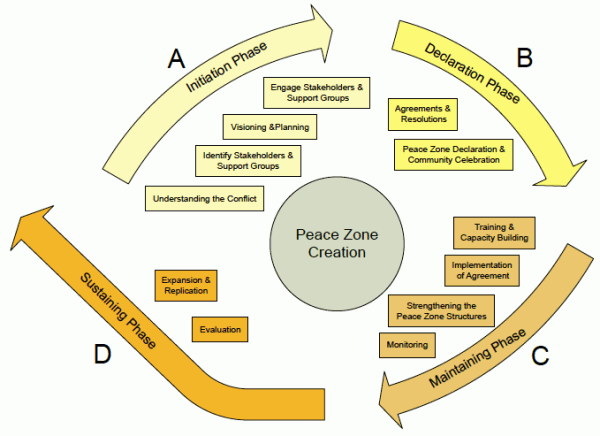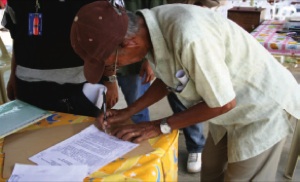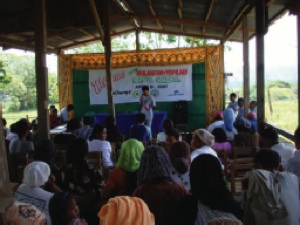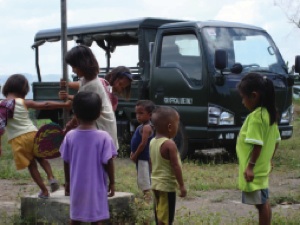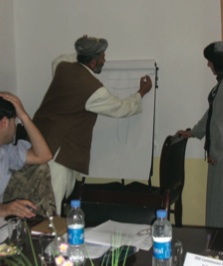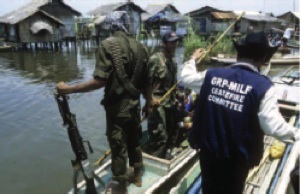Peace Zones - Principles and General Procedures
|
|
A. Minimum Pre-conditions:
|
|
|
B. Success Factors:Even though the specific fabric of each individual Peace Zone is defined by a combination of success factors, variations in the individual design of each Peace Zone is important. Some of the success factors include:
|
 |
Phases and Stages of Peace Zone Initiation, Declaration, Maintaining and Sustaining
Figure 2: Stages Creation of Peace Zones |
 |
A. Initiation PhaseStage 1: Understanding the ConflictA better understanding of the historical-political antecedents and dynamics of a conflict is necessary in order to fully design an effective intervention. An array of tools are developed as aids in understanding these dynamics. Prior to the declaration of the area as Peace Zone, tools like conflict mapping can be used as a initial analysis step. A brief history of the conflict needs to be developed with focus on the parties of the conflict, each party’s demands, interests and alliances. A time-line of the history of armed confrontations including clashes between government and rebel forces, tribal wars, inter-ethnic conflicts, forced evacuation, various acts of aggression as well as the gradual cessation of hostilities should be elaborated. A short inventory of the casualties and damages of the conflict, which highlights who were affected in what ways helps to shed light on the nature of the conflict. The assessment of the impact should be differentiated according to ethnic group, gender, economic groups etc. Stage 2: Identify Stakeholders and Support GroupsThe roles and relationships as well as the interests of different stakeholders and support groups (peace advocates, armed groups, government, NGOs, POs, donor agencies) initiating, declaring, maintaining and sustaining the Peace Zone need to be defined. Further, one needs to describe the capacities and constraints of each of these actors and participants and to identify specific characteristics according to their position in the community (e.g. as rebels, as minorities, as women, as NGOs, etc.). Stage 3: Visioning and PlanningTo guide the planning process, the community needs to develop and agree on its vision of peace and development and Peace Zone creation. It is of prime importance to define who initiates the cease fire or peace dialogue and to envision the process of resource and community mobilisation for peace. Moreover, major factors and forces that lead to the creation of the Peace Zones and their means of influencing their fabric have to be identified. Necessary inputs such as funding, human resources, stakeholders, resource persons, facilitators and logistical support are to be included in the plan. Stage 4: Engage StakeholdersCommunity leaders involved in conflict resolution and the management of the Peace Zone and their respective roles are to be identified. One of their main tasks is to initiate and facilitate negotiations and dialogue between all stakeholders (including representatives of armed groups) in the initiation phase as well as during the following phases so that a consensus will be agreed on. At this stage inclusiveness regarding the engagement of stakeholders is of prime importance, since one opposing group alone could threaten the success of the Peace Zone.
B. Declaration PhaseStage 5: Agreements and ResolutionsIn order to ensure accountability of the stakeholders, agreements and resolutions have to be drafted and implemented. The agreement should explicitly state the objectives, expectations, roles, policies, responsibilities and commitments of the stakeholders. The documents are essential in pushing the process for creation of Peace Zones. During the process of forging the agreements, the organizations will also develop relationships and become more knowledgeable about each other. However, it is also imperative to periodically review or update the agreement and resolutions when the actors and/or the context change.
Photo 1: Signing the Peace Zone Agreement
Photo 2: Getting all involved
Stage 6: Peace Zone Declaration and Community CelebrationOne important document to be drafted and signed by all stakeholders is the Peace Zone declaration. A decision has to be made on who takes part in the process of writing this unified statement, and what the contents of the declaration are. By means of consultations with community members consent about the content of the declaration has to be reached. Moreover, decisions have to be made on who signs the declaration, how and where. Photo 3: Formalities prior to celebrating
Photo 4: All benefit from peace, especially the children
C. Maintaining PhaseStage 7: Continuous Capacity DevelopmentDifferent sets of skills, knowledge and attitudes should be enhanced among the local leaders and the community members as well. It is in this line that capacity development should be part of the continuing processes of maintaining the Peace Zone. Furthermore, a network of support should be established so that local initiatives can be carried out to strengthen the peace-building mechanisms in the Peace Zone. Participation, leadership roles and interest representation are to be defined according to gender, ethnic group, economic status, in the process of capacity building and the setup of support networks. Although the steps have been defined sequentially, in reality many steps run in parallel, in particular the monitoring step 10 defined below has to commence early as part of the overall process. Stage 8: Implementation of the AgreementTo effectively implement the agreements of the Peace Zone, community leaders and their support groups should move on from being ‘brokers of peace’ to managers and implementors of conflict settlement mechanisms. The organizational body of the Peace Zone can be a peace council, tribal council, task force, local coalition or council of stewards, or a combination of some of the groups. Existing structures and systems in the community can be utilized or revitalized, rather than setting up new additional ones. Such existing structures and systems could be local government units like regional councils, traditional tribal councils or religious organizations. In contexts of inter-religious or inter-ethnic conflicts, specific policies or accommodations are to be made to ensure equal voice and participation in the peace body. Culture-based and culturally-appropriate mechanisms need to be applied. Photo 5: It is important is that all participate, including the army
Stage 9: Strengthening the Peace Zone StructureOnce the Peace Zone has been established, additional mechanisms and instruments such as additional peace education and formation of peace volunteers should be utilized in order to further strengthen the Peace Zone. The organizational structure can also be improved through the establishment of committees with specific responsibilities and tasks (e. g. management, finance, peace-building, and education committees among others). Stage 10: MonitoringA monitoring scheme must be established to ensure the successful implementation of declarations, as well as additional peace agreements and resolutions. This is a continuous process that has to be undertaken from the very start. Initially, minimum requirements as parameters for success are to be defined. The scheme has to be capable to monitor violations and breaches in the peace agreement and to assess by what party they were conducted. This should also include approaches on how to address and deal with the violations. Additionally, reasons for the violations, as well as other problems in the use of local conflict resolution mechanisms should also be subject to monitoring. Photo 6: Monitoring the peace process
D. Sustaining PhaseStage 11: EvaluationThe successes or failures in reaching the goals of the Peace Zone declaration have to be evaluated in order to inform the community and their leadership on how to move the Peace Zone forward.
Stage 12: Replication and ExpansionBased on lessons learned from the evaluation process, recommendations for the future design of the Peace Zone can be derived. In order to do so, factors for success of community-based Peace Zone management and peace-building practices have to be identified. Recommendations should lead to improvements regarding all initiation, declaration, implementation, and sustaining components of people-initiated Peace Zones. |

